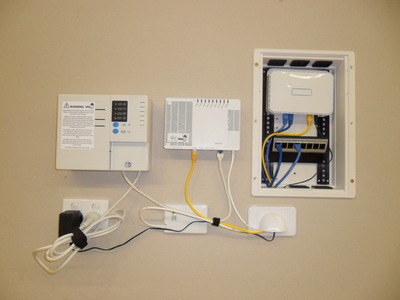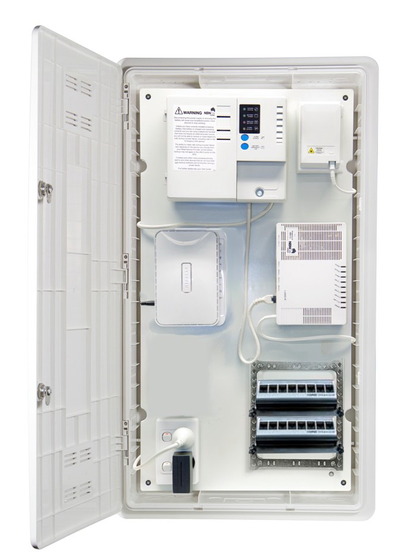Scoping for the NBN in new homes
Monday, 17 December, 2012
The NBN is rolling out nationwide, presenting new opportunities for cablers and installers. Finding a cabling solution for new housing developments that takes into account the potential requirements of a range of residents requires cooperation with the builder and a bit of consideration at the planning stage.
Modern homes are built to meet the needs of a diverse range of residents: families, students, professionals, downsizers and many others. High-density living attracts a diverse range of occupants who may stay only a short time or plan to retire in a home for life. This mix of people and needs is so complex that developers really need to offer flexible and dynamic building designs in order to attract investment. As cablers and installers, there is a need to provide adaptable installations that meet the current and future requirements of the contemporary resident.
The advent of the National Broadband Network (NBN) and fibre to the home (FttH) projects provides an avenue for cablers and installers to truly add value to an installation. These schemes present the ability to offer competitive options for service delivery, such as internet and television, and the scope to expand and evolve over time. In order to provide the best solution possible, electrical professionals need to think beyond pulling wire. It really pays to have a clear view of the big picture and factor in the following: understand the long-term value of the communications infrastructure as a utility and make it a real part of the home design; provide space for networking equipment that can be upgraded over time; and install quality data cabling, including TV locations.
The design of new homes and apartments does provide some challenges though. Apartments, in particular, can be short on available space. Installers are required to find inventive solutions to utilise available space for all components: the electronic hardware, wiring and all the connecting cables. In addition, there is the value of workmanship and the importance of safety to consider.
When planning the installation, a number of factors need to be considered: how much space the equipment and cables will need (the NBN Co provides guidelines on standard NBN equipment and the clearances required in a document titled ‘Key Information for Builders and Cablers’); how electronic equipment can be cooled - will venting be needed if the equipment is enclosed?; wireless device compatibility; how to make the installation safe, including consideration of patch cords and routers); how to protect the installation from accidental damage; future-proofing to allow for equipment size changes; making the installation look neat to match the investment of the home and included appointments; factoring in future buyers whose needs may be very different; and providing easy access for repairs or changes.
As with making any design decision, it’s best to compare options. The first option is also probably the most cost-effective solution and illustrated in Figure 1. To facilitate equipment installation, this alternative requires the provision of nothing more than wall space by the developer or homeowner. Standard equipment includes the network termination device (NTD) supplied by the network provider and the backup power equipment, along with provision for any required routing gateways from internet or television service providers. All of this equipment is typically wall surface mounted and will require the provision of power. Connections for in-home cabling to rooms and equipment locations can be provided using cables terminated on faceplates that house the number of outlets required for the installation. The faceplates would ideally feature integral labels, providing the user with an easy identification system, clearly demonstrating where the sockets correspond to the cabled wall outlets in the residence.

The second option, illustrated in Figure 2, demonstrates a solution with provision for a dedicated enclosure for cabling. Rather than faceplates, the housing uses patch panels to provide a higher density concentration of connections, as well as neatly housing the excess cordage from connecting leads.

In this instance, the NTD, backup power equipment and routing gateways still require space to locate externally on a wall surface. As shown in the installation illustration, the home distributor would most likely be mounted adjacent to the network provider equipment. While providing a higher concentration of network connections, this option leaves equipment exposed. This may be useful for service access, but can lead to accidental damage or unwanted interference.
The third option, illustrated in Figure 3, is to provide a housing for the majority of the equipment and cabling. Ideally, this housing is an enclosure that can accommodate a large number of outlets, as well as providing an avenue for unexposed power for the equipment. Use of such an enclosure also provides the ability to recess the distributor into a wall cavity, ensuring that the door can be closed to provide a greater level of safety, storage and protection from accidental damage.

From a safety and an aesthetic point of view, this option could be described as ‘ideal’. In this installation the equipment and cabling can be co-located, while the enclosure provides vents for active equipment and is made of a non-metallic material to allow for the fitting of wireless networking equipment. The internal space will accommodate equipment from a variety of network providers and service providers, as well as facilitate home networking needs. In addition, most of the enclosure can be recessed in the wall cavity, allowing for many connectivity options and for customers to specify one enclosure for nearly all applications. From a future-proofing perspective, this solution caters to the needs of a variety of residents, avoiding a scenario where valuable wall space is taken up by additional equipment, creating a less than aesthetically pleasing outcome.
Given that the NBN rollout is the largest infrastructure project in Australia, it’s no surprise that there is a lot of information available to the consumer. The NBN Co website contains published documents on every aspect of the development: from the planned rollout timetable through to end-user troubleshooting guides, so it’s fair to assume that most consumers will be fairly informed on the available options. This is an opportunity for the electrical contractor to work with builders and developers to ensure that the solution being delivered is the best option for the project, not simply the cheapest or most convenient. As outlined, there are a range of options when providing a power and communications wiring solution for the NBN, but it is certainly advisable to consider future requirements and to treat communications as a new utility that requires its own space and careful planning to make the most of the technology on offer in the new competitive communications world.
Luminous running trail utilises IoT tech, wins awards
The Jinji Lake Luminous Trail, a project developed by China's Suzhou Industrial Park, has...
Are we dangerously dependent on submarine cables?
A new study warns that submarine communication cables are increasingly vulnerable to both natural...
Rethinking data centre sustainability
In this interview, Terry Maiolo, VP & General Manager for Asia Pacific at cloud computing...



